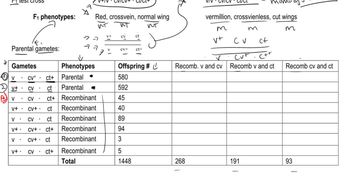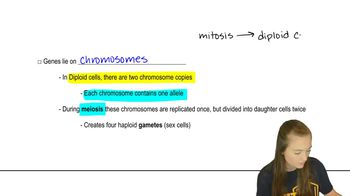Green scales (G) in a particular species of fish is dominant over blue scales (g). The following crosses are carried out, producing the progeny shown. Write out all possible genotypes of the parents in each cross.
Table of contents
- 1. Introduction to Genetics51m
- 2. Mendel's Laws of Inheritance3h 37m
- 3. Extensions to Mendelian Inheritance2h 41m
- 4. Genetic Mapping and Linkage2h 28m
- 5. Genetics of Bacteria and Viruses1h 21m
- 6. Chromosomal Variation1h 48m
- 7. DNA and Chromosome Structure56m
- 8. DNA Replication1h 10m
- 9. Mitosis and Meiosis1h 34m
- 10. Transcription1h 0m
- 11. Translation58m
- 12. Gene Regulation in Prokaryotes1h 19m
- 13. Gene Regulation in Eukaryotes44m
- 14. Genetic Control of Development44m
- 15. Genomes and Genomics1h 50m
- 16. Transposable Elements47m
- 17. Mutation, Repair, and Recombination1h 6m
- 18. Molecular Genetic Tools19m
- 19. Cancer Genetics29m
- 20. Quantitative Genetics1h 26m
- 21. Population Genetics50m
- 22. Evolutionary Genetics29m
2. Mendel's Laws of Inheritance
Monohybrid Cross
Problem 1d
Textbook Question
Compare and contrast the following terms:
Monohybrid cross and Test cross
 Verified step by step guidance
Verified step by step guidance1
Understand the definition of a monohybrid cross: A monohybrid cross involves the mating of two individuals with different alleles at one genetic locus of interest. It is used to study the inheritance of a single trait. For example, crossing a plant with genotype (heterozygous) with another plant of genotype .
Understand the definition of a test cross: A test cross is used to determine the genotype of an individual with a dominant phenotype. This is done by crossing the individual with a homozygous recessive organism. For example, crossing a plant with genotype (unknown dominant phenotype) with a plant of genotype (homozygous recessive).
Compare the purpose of the two crosses: A monohybrid cross is used to study the inheritance of a single trait and observe the resulting phenotypic ratios, while a test cross is specifically designed to reveal the genotype of an individual with a dominant phenotype.
Contrast the genetic setup: In a monohybrid cross, both parents can be heterozygous or have different alleles at the locus of interest. In a test cross, one parent is always homozygous recessive to ensure the dominant phenotype's genotype can be determined.
Summarize the key difference: A monohybrid cross focuses on inheritance patterns and ratios, while a test cross focuses on identifying unknown genotypes.
 Verified video answer for a similar problem:
Verified video answer for a similar problem:This video solution was recommended by our tutors as helpful for the problem above
Video duration:
2mPlay a video:
Was this helpful?
Key Concepts
Here are the essential concepts you must grasp in order to answer the question correctly.
Monohybrid Cross
A monohybrid cross is a genetic cross between two individuals that differ in a single trait, typically involving one gene with two alleles. This type of cross helps to determine the inheritance pattern of that trait, illustrating the principles of dominance and segregation. For example, crossing a homozygous tall plant with a homozygous short plant will yield offspring that are all heterozygous for height.
Recommended video:
Guided course

Monohybrid Cross
Test Cross
A test cross is a breeding experiment used to determine the genotype of an individual exhibiting a dominant phenotype. This is achieved by crossing the individual with a homozygous recessive individual for the trait in question. The phenotypic ratios of the offspring will reveal whether the dominant individual is homozygous or heterozygous, providing insight into its genetic makeup.
Recommended video:
Guided course

Trihybrid Cross
Genetic Inheritance
Genetic inheritance refers to the process by which genetic information is passed from parents to offspring through alleles. Understanding inheritance patterns, such as those observed in monohybrid and test crosses, is crucial for predicting traits in future generations. This concept is foundational in genetics, as it encompasses Mendel's laws of segregation and independent assortment, which govern how traits are inherited.
Recommended video:
Guided course

Diploid Genetics
Related Videos
Related Practice
Open Question
445
views
10
rank
2
comments


